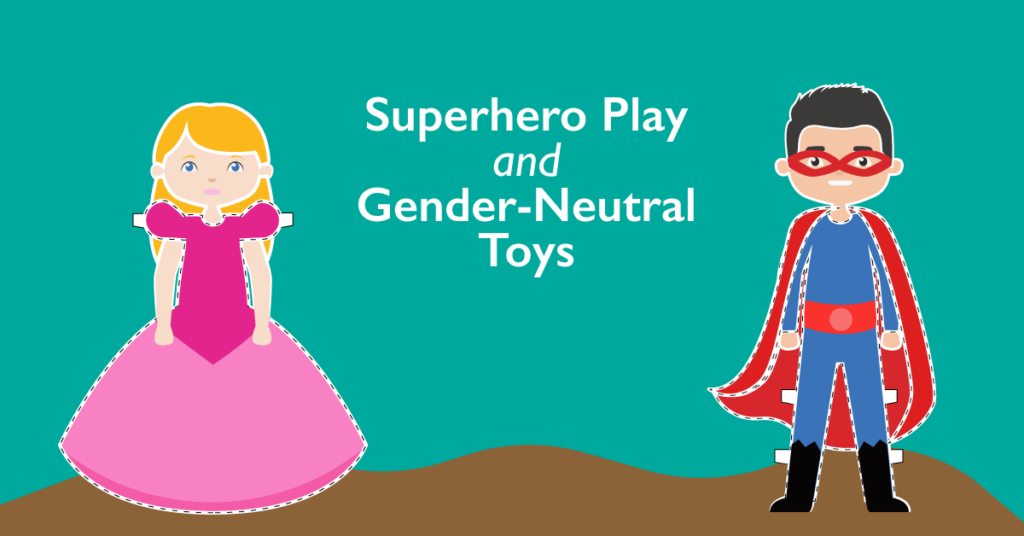Gender-neutral toys and play are hot topics right now, and one that’s surprisingly polarizing. On the one side are the conservatives who, as always, feel that the entire social order is being thrown into crisis by not clearly delineating gender in toys. On the other hand, the more liberal voices, as always, blame the piece of plastic for an inherent cultural situation.
Let me say unequivocally that toys reflect a culture and a culture’s views and values. An inert lump of polyvinyl chloride (or any polymer you choose) does not and cannot create or reinforce gender stereotypes. That comes exclusively through the views and behavioral modeling of parents, adults, and media. So, if Target wants to promote that toys are gender-neutral and rearrange its shelves, fine. Will it make any difference? No. Well, at least not beyond the marketing boost it gets, which allows people to feel good about themselves, and perhaps a bit superior if you read a lot of the stuff that’s being written.
Now, the one thing I will happily concede and applaud is the growing sentiment both in the U.S. and overseas that children should play with the toys that resonate with them regardless of so-called traditional gender skew. This is not a “toy” issue; it’s a cultural issue. If an adult does not impose his or her gender biases on a child, the child is less likely to internalize them.
The fact of the matter is, however, that boys and girls do play differently. Children become aware of gender at about age 2, but they don’t start to gender differentiate in their play till about age 4. At that time, how they play begins to show marked distinction based on gender. Every child is different, but for the most part, boys tend towards power and conflict, while girls tend towards nurturing and cooperation. That’s just the way it is.
In the toy biz, we’re seeing this in the proliferation of superheroes being targeted to girls. Barbie in Princess Power last year, and Barbie in Spy Squad this year. Warner Bros. and DC Comics has launched DC Superhero Girls. These are in addition to classic Marvel, Star Wars, Batman, Transformers and myriad other characters. And girls love them. What’s significant about these, however, is that what might traditionally have been a boy’s toy or play pattern has been re-interpreted to appeal to the way girls actually play. All you have to do is look at the storylines to understand the difference. Every one of these has the superheroes cooperating and solving problems to save the day. Now, boys like to save the day, too, but in their play, they typically do so by destroying an enemy, rather than enrolling or trying to convert the enemy.

Even with the different styles of play, superhero play serves kids of both genders in some very similar ways. This kind of play is very empowering, allowing kids to see themselves in a heroic light. It gives them the vicarious experience of making something happen for good and of being the person in control of a positive outcome. They can imagine that they have great powers, and that’s beneficial for physical, cognitive, and emotional development. Moreover, as I have often said, when kids feel small and powerless in the world at large, superhero play allows them to feel brave, confident, and in control. These feelings developed at an early age are transferrable to their non-play interactions.
Here are five simple tips parents and caregivers can use to ensure that they’re providing a positive play experience for kids:
- Let the child choose whatever he or she wants to play with at any given time. Whether blocks, trucks, dolls, puppets, allowing the child to be in control of the play experience is empowering to him or her.
- Avoid imposing your personal views. If you say, “that’s a girls’ toy or that’s a boys’ toy,” you create the gender distinction, which the child then takes as true. This is particularly true for younger children—ages 3–5.
- Ask questions. If you child is sharing a story he or she has made up about a toy, ask questions about the story rather than trying to direct it. Remember, the logic and narrative structure a 4-year-old comes up with is very different than that of an adult.
- Watch your language. If you want to avoid cultural stereotypes about gender, don’t use them. Your child will absorb more points of view from you than from the toy.
- Play along. One of the most empowering things you can do when your child in play is to let him or her lead the experience. You’re in charge most of the time, let the child drive the bus in play.
Most importantly, have fun with your kids and encourage them to have fun. Spend less time worrying about gender and more in play. You’ll have a better time.

